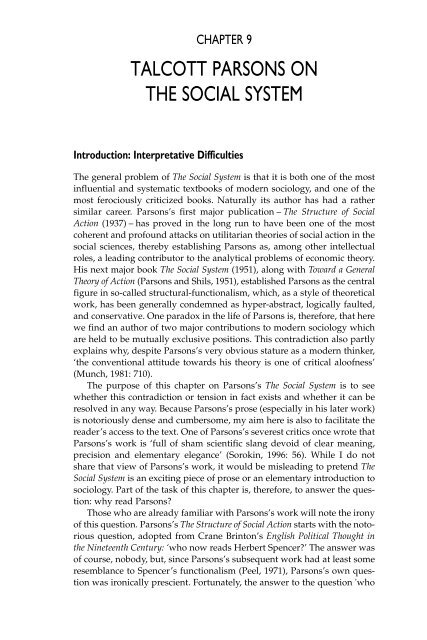You also want an ePaper? Increase the reach of your titles
YUMPU automatically turns print PDFs into web optimized ePapers that Google loves.
CHAPTER 9<br />
TALCOTT PARSONS ON<br />
THE SOCIAL SYSTEM<br />
Introduction: Interpretative Difficulties<br />
The general problem of The Social System is that it is both one of the most<br />
influential and systematic textbooks of modern sociology, and one of the<br />
most ferociously criticized books. Naturally its author has had a rather<br />
similar career. Parsons’s first major publication – The Structure of Social<br />
Action (1937) – has proved in the long run to have been one of the most<br />
coherent and profound attacks on utilitarian theories of social action in the<br />
social sciences, thereby establishing Parsons as, among other intellectual<br />
roles, a leading contributor to the analytical problems of economic theory.<br />
His next major book The Social System (1951), along with Toward a General<br />
Theory of Action (Parsons and Shils, 1951), established Parsons as the central<br />
figure in so-called structural-functionalism, which, as a style of theoretical<br />
work, has been generally condemned as hyper-abstract, logically faulted,<br />
and conservative. One paradox in the life of Parsons is, therefore, that here<br />
we find an author of two major contributions to modern sociology which<br />
are held to be mutually exclusive positions. This contradiction also partly<br />
explains why, despite Parsons’s very obvious stature as a modern thinker,<br />
‘the conventional attitude towards his theory is one of critical aloofness’<br />
(Munch, 1981: 710).<br />
The purpose of this chapter on Parsons’s The Social System is to see<br />
whether this contradiction or tension in fact exists and whether it can be<br />
resolved in any way. Because Parsons’s prose (especially in his later work)<br />
is notoriously dense and cumbersome, my aim here is also to facilitate the<br />
reader’s access to the text. One of Parsons’s severest critics once wrote that<br />
Parsons’s work is ‘full of sham scientific slang devoid of clear meaning,<br />
precision and elementary elegance’ (Sorokin, 1996: 56). While I do not<br />
share that view of Parsons’s work, it would be misleading to pretend The<br />
Social System is an exciting piece of prose or an elementary introduction to<br />
sociology. Part of the task of this chapter is, therefore, to answer the question:<br />
why read Parsons?<br />
Those who are already familiar with Parsons’s work will note the irony<br />
of this question. Parsons’s The Structure of Social Action starts with the notorious<br />
question, adopted from Crane Brinton’s English Political Thought in<br />
the Nineteenth Century: ‘who now reads Herbert Spencer?’ The answer was<br />
of course, nobody, but, since Parsons’s subsequent work had at least some<br />
resemblance to Spencer’s functionalism (Peel, 1971), Parsons’s own question<br />
was ironically prescient. Fortunately, the answer to the question 'who

















